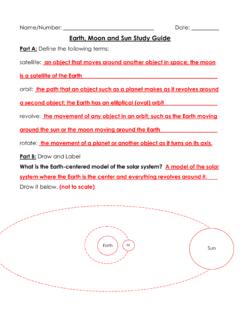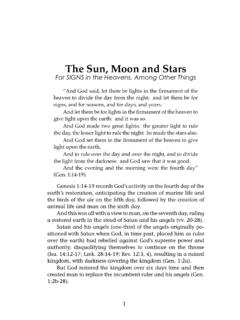Transcription of Answers for the Study Guide: Sun, and Moon Test
1 Name_____ Date_____ Period _____ Golden Study guide S E M Test 1 Answers for the Study guide : Sun, Earth and moon Relationship Test 1) It takes one day for the Earth to make one complete _____ on its axis. a. Rotation 2) It takes one year for the Earth to make one _____ around the sun. a. Revolution 3) The tilt of the earth on its axis creates_____. a. seasons 4) What change would occur if Earth s rate of rotation significantly decreased? a. The day would be longer. 5) Why can we see the moon at night even though it does not produce any light? a. The moon reflects the light from the sun 6) What moon phase does a lunar eclipse occur in? a. Full moon 7) When the moon blocks the Earth from the sun a _____ _____ occurs.
2 A. Solar Eclipse 8) What is the position of the Earth, Sun and moon during a lunar eclipse? a. Sun, Earth, moon 9) What is the position of the Earth, Sun and moon during a solar eclipse? a. Sun, moon , Earth 10) A complete moon cycle is how many weeks? a. 4 11) How many low and high tides occur in one day? a. 4 12) When the sun/ moon s gravity are working together, this type of tide occurs. a. Spring Tide 13) When the sun s/ moon s gravity are working against each other, this type of tide occurs. a. Neap Tide 14) What moon phase(s) occur during a spring tide? a. Full and New moon 15) What moon phase(s) occur during a neap tide? a. 1st and 3rd (last) Quarter Name_____ Date_____ Period _____ Golden Study guide S E M Test 2 16) How many hours are between each high tide and low tide?
3 A. 6 hours 17) This diagram represents which type of tide? a. High tides (new moon phase) Spring Tide 18) Can a solar eclipse and spring tide ever occur at the same time? a. Yes, during a new moon phase. 19) Why can t we see a new moon on earth? a. The side of the moon that we can see from the Earth is not lit from the sun. The position of the sun, earth and moon during a new moon phase is Sun, moon then Earth. The moon is between the Earth and the sun causing the side of the moon facing the sun to block the sunlight from the other side of the moon (the side we see on Earth). Sun moon Earth 20) What does waxing mean? a. The lighted part of the moon starts to grow from right to left (Jack) 21) What does waning mean?
4 A. The lighted part of the moon starts to shrink from right to left (Jill) b. Or the shadow on the moon starts to grow from right to left 22) Draw a diagram of the Sun, Earth and Moons for all the moon phases. Shade in the phase and label it. Name_____ Date_____ Period _____ Golden Study guide S E M Test 3 23) Draw a diagram of the 4 seasons using the sun and the earth (tilted). Label each solstice and equinox and write the date they occur on. Name_____ Date_____ Period _____ Golden Study guide S E M Test 4 24) Draw and label a solar and lunar eclipse using the following terms in each: Umbra, Penumbra, Partial Eclipse and Total Eclipse.
5 Solar Eclipse: Sun moon Earth In the penumbra there would be a partial eclipse and in the umbra there would be a total eclipse. Name_____ Date_____ Period _____ Golden Study guide S E M Test 5 Lunar Eclipse: Sun Earth moon In the penumbra there would be a partial eclipse and in the umbra there would be a total eclipse. Name_____ Date_____ Period _____ Golden Study guide S E M Test 6 25) Describe how the length of daylight changes from the Equator to the North Pole on the date shown and explain the reasoning for your answer. a. There is more daylight at the Equator than at the North Pole 26) If the last high tide was at 4:00 am when will the next high tide be?
6 A. 4:00 pm because there will be a low tide in 6hours and another high tide in an additional 6 hours after the next low tide or (12 hours from the last high tide) Name_____ Date_____ Period _____ Golden Study guide S E M Test 7 SHADOWS 27) What is a shadow? A. is an area where direct light from a light source cannot reach due to obstruction by an object 28) How can you make a shadow larger or smaller? (Draw and explain) With the light stationary, if the object is closer to the light source, the shadow is smaller. If the object is farther away, the object is larger. 29) What type of material makes the best shadows? (Transparent_____, Translucent _____, or Opaque _____) Opaque 30) How many objects, at minimum, are needed to create a shadow?
7 3 The light, the object blocking the light and the surface Larger Smaller Name_____ Date_____ Period _____ Golden Study guide S E M Test 8 31) Using the shape given and the light, draw the shadows. Using the figurine and the light, record how the shadows change sizes. 32) Why do we have different seasons in the northern hemisphere than the southern hemisphere? Winter: Earth s axis is pointed away from the sun Summer: Earth s axis is pointed toward the sun The tilt of the Earth on its axis creates seasons. When the northern hemisphere is pointed toward the sun we are experiences summer but that causes the southern hemisphere to be pointed away from the sun, which creates winter and vise versa.
8 When the Earth (NORTHERN HEMISPHERE) is tilted toward the Sun more direct energy (HEAT) enters the atmosphere. 33) Why doesn t an eclipse occur every full moon ? Name_____ Date_____ Period _____ Golden Study guide S E M Test 9 When the Earth (NORTHERN HEMISPHERE) is tilted away from the Sun energy (HEAT) is concentrated more in the Southern Hemisphere. 34) If a high tide occurs at 6 and At what time will the low tides occur? There are 24 hours in a day and 4 high and low tides total in a day so 24/4 = 6 hours each high and low tide are apart. Low tides are at 12 and 12 35) If the tilt of the Earth s axis increased what would be the effect of the seasons? Result: More extreme summers and winter Longer summer days, shorter winter days in the higher latitudes 36) Explain how the angle of insolation hitting the earth affects the amount of heat received by the earth s surface?
9 When the Earth (NORTHERN HEMISPHERE) is tilted away from the Sun energy (HEAT) is concentrated more in the Southern Hemisphere, causing cooler temperatures in the northern hemisphere. When the Earth (NORTHERN HEMISPHERE) is tilted toward the Sun more direct energy (HEAT) enters the atmosphere, causing warmer temperatures in the northern hemisphere. Name_____ Date_____ Period _____ Golden Study guide S E M Test 10 37) Draw and label a neap tide with the pull of gravity and inertia, water bulge, high and low tide labeled, moon phase shaded correctly for a third quarter moon . 38) Draw and label a spring tide with the pull of gravity and inertia, water bulge, high and low tide labeled, moon phase shaded correctly for a full moon .
10 Earth Earth GravityandInertiaGravity InertiaInertiaName_____ Date_____ Period _____ Golden Study guide S E M Test 11 Name_____ Date_____ Period _____ Golden Study guide S E M Test 12 Study guide : Sun, Earth and moon Relationship Test 1) It takes one day for the Earth to make one complete _____ on its axis. 2) It takes one year for the Earth to make one _____ around the sun. 3) The tilt of the earth on its axis creates_____. 4) What change would occur if Earth s rate of rotation significantly decreased? 5) Why can we see the moon at night even though it does not produce any light? 6) What moon phase does a lunar eclipse occur in? 7) When the moon blocks the Earth from the sun a _____ _____occurs.












